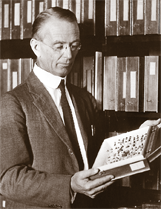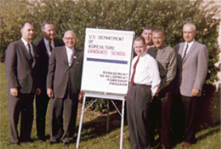Our Beginning
How it all started, and the people behind the vision
Agriculture scientists who wanted more than on-the-job education faced a tough dilemma. During World War I and after, USDA policy discouraged scientists from taking time off their jobs to get advanced graduate-level training at universities. In 1920, a joint congressional salary commission criticized USDA personnel policies, especially its reluctance to grant leave for graduate training. Something had to be done: more than 400 scientists had quit their USDA jobs between 1910 and 1919. The demand for formal education was strong. Elmer Ball, a USDA scientist brought in to help reorganize the department’s scientific establishment, was asked to come up with a solution.
A change was needed.

In April 1921, Ball wrote to Secretary of Agriculture Henry C. Wallace and proposed a system of graduate training within the department, supplemented by cooperative arrangements with universities and agriculture colleges, to further employee education and lead to advanced degrees. Wallace approved the proposal and tasked him with leading a committee to formulate ground rules for an educational program along the lines of the school then run by the Bureau of Standards.
With the help of Henry C. Taylor, an administrator who had already started in-service lectures to help his employees apply their educations to agriculture problems, the committee came up with six fundamental guidelines:
- The proposed graduate school would provide training to scientists, helping them advance within the department.
- Instruction should be carried on after office hours.
- The school would be supported by student fees.
- Arrangements would be made for the acceptance of these credits by the graduate departments of leading universities.
- There would be cooperation with other institutions in Washington.
- The Department would modify its administrative regulations to encourage student participation in the graduate school and other universities.
In creating the school, the Department of Agriculture established a principle that has remained at the heart of its educational policy ever since: that the government, and therefore the public, will be better served if employee needs are met.
In the 1920s, the idea was that students should be able to take one course a semester at the USDA Graduate School and later transfer their credits to a university and complete their degrees. The school was an instant success. Elmer Ball’s vision of graduate-level training for USDA scientists grew an institution created to meet the needs of all federal employees, across the nation and around the world.
Within ten years, the USDA Graduate School was teaching federal employees from all government agencies, in Washington D.C. and across the country.
Dr. Ball said, “I believe those who may be able to avail themselves of this opportunity will both enrich themselves and enhance the value of the service they render.”
One hundred years later, we are still living by those words.

OUR BEGINNING
How did it all start? Learn about the origins of Graduate School USA and the people behind the vision.

OUR NAME
We don’t award degrees. Why are we called “Graduate School” USA? Let us tell you.

HISTORICAL TIMELINE
Explore our rich and diverse history: 100 years of GSUSA instructors, curriculum areas, and dedication to the federal workforce.

OUR INSTRUCTORS
For over 100 years, we have had thousands of outstanding instructors. Meet some of them.

AROUND THE WORLD
For over 60 years, our outstanding training has gone around the world. Read our story about our international training.

LEADERSHIP TRAINING
We were the first organization to offer leadership training to government professionals. Hear from those who have benefited from our training.

